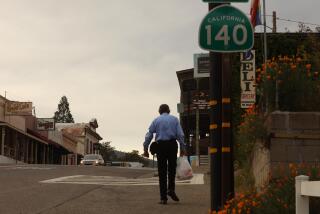Hollenbeck Home for the Aged in Boyle Heights in the 1890s
- Share via
Growing old without money, not good. Growing old without money and in poor health, very bad. This is the future some of us face as 401(k)s dwindle and insurance doesn’t cover all the medical bills.
In the 1880s and ‘90s, another era of great prosperity for the few, similar conditions prevailed. Without government programs, Americans looked after themselves as best they could. When children left home, parents moved to small apartments and boarding houses where they depended on neighbors for help.
Slowly, an imperfect world of welfare developed, supported by sectarian charities and pious citizens who encouraged giving and sharing. For some, looking after the old and the indigent, the orphaned and the mentally challenged was a civic duty.
Here in Los Angeles, the Catholic Sisters of Charity opened an orphanage in 1890. Six years later, clergy and businessmen dedicated the Hollenbeck Home for the Aged in Boyle Heights east of downtown. Octavius Morgan and John Walls, designers of the Pantages Theater, were the architects of the Mission-style building, set in a garden facing west to the Los Angeles River and Pacific Ocean beyond. Their patron was the intrepid Elizabeth Hollenbeck.
Born in 1827 in Germany, she married the entrepreneurial John Hollenbeck from Connecticut in 1853. At the time, they were living in Costa Rica, catering to traders and adventurers headed west and south. When their only child was born a year later, the Hollenbecks brought him north to be raised by his grandparents in what they thought was healthful Illinois. Three years later, he died of diphtheria while his parents were still in Central America.
In 1876, physically diminished by years in the tropics, John and Elizabeth moved to Los Angeles, America’s capital of opportunity and well being.
They became rich from transportation, hotel and land development. They paved L.A.’s first streets, built early rail lines, and, with partners, created what became Exposition Park. They settled into a modest villa in a garden along South Boyle Avenue. They built the house with a room for John’s father, who died before he could move in. After only nine years in California, John Hollenbeck, at 56, died at home from a stroke. His wife buried him in nearby Evergreen Cemetery.
Elizabeth forged on, well acquainted with her generation’s tenuous hold on good health. She was confirmed in the Presbyterian church and encouraged to pursue philanthropy. The manager of a home for the aged in Brooklyn, N.Y., suggested she open one for the poor in L.A.
After finessing a state law that restricted charitable gifts to one third of a person’s net worth, Elizabeth Hollenbeck established a trust to build and maintain a home for the elderly on land contiguous to her Boyle Heights garden. In 1892, with former Los Angeles Mayor William Workman, she created Hollenbeck Park across the street from where Morgan and Walls began construction three years later.
It was a blue-sky Sunday when guests arrived to dedicate the Hollenbeck Home for the Aged. Its superintendent, the Rev. Daniel W. Hanna, addressed the crowd on behalf of Elizabeth.
“To be rich is the common desire, thinking little of the heavy responsibilities that riches bring,” he said. “Wealth is a power that should bring blessings in its wake. . . . It is the great dynamo . . . which builds our railroads, ocean steamers, towns and cities.”
Wealth also oppresses, bribes and corrupts, Hanna said, and yet through wealth, this pile of brick, lime, wood and iron “becomes a home for the aged, a protection to the destitute.”
With this somber challenge to her fellow millionaires, Elizabeth Hollenbeck welcomed the home’s first boarders. One year later, 34 women and 12 men representing eight nationalities and eight faiths had been admitted. They were, as one recalled, the “fortunate unfortunates.” They were older than 60, residents of California and without sufficient financial support. At the home they were secure, their expenses paid for life.
On the 33rd anniversary of her husband’s funeral and the 22nd anniversary of the dedication, Elizabeth Hollenbeck died on Sept. 6, 1918. When investment losses mounted in the Depression, the Hollenbeck Home for the Aged admitted residents who came with assets. In 1985, the Hollenbeck Trust razed the brick home and built a stucco facility to code.
Today the institution survives as Hollenbeck Palms -- no longer free, but still caring.
More to Read
Sign up for Essential California
The most important California stories and recommendations in your inbox every morning.
You may occasionally receive promotional content from the Los Angeles Times.













